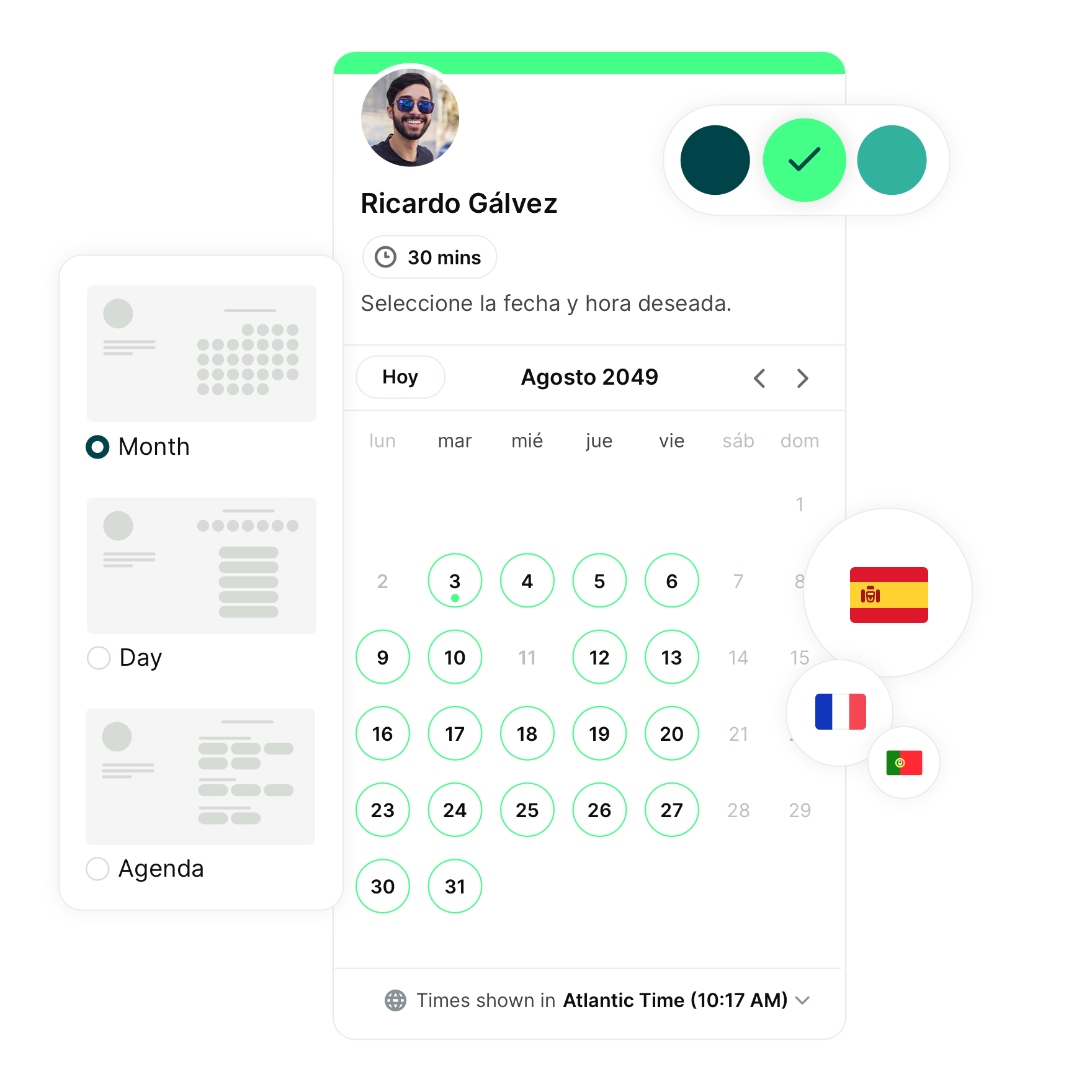8 Booking Form Templates That Actually Get You More Clients
Stop losing bookings! Learn how to create the perfect form with expert tips, best practices, and free booking form templates.

Paulina Major

Ready to book more meetings?

A good booking form needs to do three things: make it easy for customers to schedule, collect the right details to facilitate the booking, and prequalify leads (if required) so you're talking to the right people.
But too often, businesses overcomplicate their forms—asking for too much information or making them confusing.
If your form is too long, people won’t book. If it’s too short, you won’t get the information you need. So how do you create a booking form that strikes the right balance?
In this guide, we’ll cover what to include (and what to leave out), best practices to keep your form simple yet effective, and real-world booking form templates you can use to inspire your own.
Let’s begin!
Why are booking forms important for your small business?
For a lot of small businesses, scheduling appointments and meetings is a big part of the day-to-day. Your booking form plays a crucial role in this process. It serves as a vital touchpoint that influences conversions, efficiency, and the overall customer experience.
Here’s why you should pay extra attention to designing your form:
- It streamlines scheduling and eliminates friction: A confusing or clunky booking process increases drop-offs. Your form should reduce unnecessary steps, auto-confirm bookings, and integrate with your calendar to eliminate manual work.
- It improves customer experience: The easier it is to schedule with you, the more likely people are to follow through. If the booking experience is frustrating, they may assume the rest of the experience will be too.
- It helps you prepare: By collecting the right details upfront—like the service they need, special requests, or relevant background info—you can show up to meetings ready to go.
- It helps you weed out the wrong leads: Not every customer is a good fit, and your booking form can help filter out time-wasters. If you’re a coach or consultant, asking a few key questions—like budget, goals, or decision-making authority—helps you focus on serious leads, not just tire-kickers.
- It cuts down on no-shows: Nobody likes getting ghosted. Adding a quick note about your cancellation policy—or making customers check a box to confirm—sets expectations upfront and reduces no-shows. People take commitments more seriously when they know there are rules.
|
👉 Don’t have a cancellation policy yet? Check out our guide on how to create an effective meeting cancellation policy. |
What should a booking form include?
A good booking form asks just enough to get the job done—no more, no less. Here’s what to ask (and not to ask):
The basics
Every booking form needs to capture essential details: who’s booking, how to reach them in case of rescheduling or cancellation, and when they want to meet.
Also, if you offer multiple services or appointment types, include a dropdown menu so customers can select what they need.
When designing your form, ensure your available time slots are clear, and if needed, leave buffer time between appointments to avoid back-to-back scheduling stress.
Lead qualifying questions (if relevant)
If you run a consulting/coaching or service-based business, you probably don’t want to waste time on leads that aren’t the right fit.
An easy way to filter them out? Add a few quick lead qualifying questions to your booking form. Just keep them relevant and to the point—only ask what you really need to know.
For example, if you’re a hairstylist, a simple question like “Have you had your hair colored in the past six months?” can help you plan the right treatment.
If you’re a marketing consultant, asking about the prospect’s budget ensures they have sufficient funds for your services.
Below, Roberto (E) Suarez demonstrates how a few simple lead qualifications in his booking form help him screen for the right coaching clients.

A Checkbox for terms & policies
No-shows and last-minute cancellations are frustrating. A simple checkbox—"I agree to the cancellation policy"—can help set clear expectations. The example from USADefend Law Firm below shows how this can be done. If you require deposits or have specific rules, be sure to mention them here too.

Any other business-specific details
Depending on what you do, you might need extra info to prepare for the appointment. Keep it brief and relevant.
Examples:
- Tutor: “What subject or topic do you need help with?”
- Handyman: “What type of repair or installation do you need help with?”
- Recruiter: “Upload your resume and provide a link to your LinkedIn profile.”
What to leave out?
Anything that doesn’t serve a clear purpose. Longer forms lead to more drop-offs, so keep it concise.
A good booking form should be short and to the point. Consider removing any questions that don’t directly impact the appointment.
Check out a few common questions below that often appear in booking forms but aren’t always necessary.
|
Question |
Why it’s bad |
What’s a better alternative? |
|
“How did you hear about us?” |
It’s a marketing question, not a booking necessity. Customers are here to schedule, not fill out a survey. |
If needed, ask this in a follow-up email after the appointment, not during booking. |
|
“What’s your full home address?” |
Unless you’re delivering a physical product or offering an in-home service, this is unnecessary and feels invasive. |
If location is relevant, just ask for city and ZIP code instead of a full address. |
|
“What’s your preferred payment method?” |
If you’re not collecting payment at the time of booking, this question adds unnecessary friction. Most customers don’t want to make that decision before they even commit. |
If prepayment is required, integrate payment into the booking form instead of just asking about it. Otherwise, handle payment at the appointment. |
Booking form design best practices
How you design your booking form matters too. It should be clean and optimized for all devices.
Let’s unpack the best design practices!
1. Keep the design clean and simple
Your booking form should feel minimal and intuitive—not like a long, complicated survey. Too many fields, unnecessary drop-downs, or cluttered layouts create friction, making people “work hard” to book an appointment with you.
2. Include only essential details—Nothing extra
It’s tempting to ask for every possible piece of information upfront. But the longer your form, the more likely people are to abandon it.
If a question isn’t absolutely necessary for confirming the booking or preparing for the appointment, leave it out.
3. Use a single-column layout for easy scanning
Apparently, studies have been done on this! According to the CXL Institute, single-column forms are completed 15.4 seconds faster than multi-column ones.
So, it would be silly not to follow this advice! Ultimately, your form should be easy to scan and quick to complete from top to bottom.
4. Make it mobile-friendly
A bad mobile experience = lost customers.
Most people book on the go, so your form needs to be touch-friendly, readable, and easy to complete on a small screen. That means large, tap-friendly fields, a responsive design that adjusts to different screen sizes, and no unnecessary scrolling or zooming.
If people have to pinch, zoom, or struggle with tiny buttons, they won’t book. Test your form on different devices to make sure it works fine!
8 Booking form template examples
Right, now that we’ve got the theoretical part out of the way, let’s jump straight into the booking form templates.
We’ve handpicked a few real-world examples so you can easily get inspired and apply the best practices to your own booking page. Whether you're a service provider, consultant, or business owner, these templates will help you structure your form for maximum efficiency and conversions.
Beauty and hair salons
If you’re designing your hair salon booking form, you need to collect essential information without making the client call in to confirm details. Customers should be able to book their appointment, choose a service, and note any special requests in just a few clicks.
🔹 Key fields to include:
- Full name and contact details (phone + email)
- Type of service (haircut, color, styling, etc.)
- Preferred stylist (optional)
- A checkbox confirming the acceptance of the cancellation policy.
Sandra Mo from Lashes by SxMO has a great booking form on her booking page to capture as much information about the client as possible before the different treatments she offers. For new clients, she also asks them to complete a new client form.👇

|
📖 Want to protect your salon from issues like late arrivals or no-shows? Check out our guide filled with salon-specific booking policy examples. |
Business coach
If you’re a business coach scheduling sessions, you don’t want to waste time on unqualified leads. Your booking form should filter out casual inquiries by collecting key business details and client goals upfront.
🔹 What you could include in your booking form:
- Name and email
- Business name (optional)
- The main challenge or goal for the session
- Preferred consultation length (60 min / 90 min)
- Budget range (if prequalifying leads)
- Price of the consultation (if you charge for it).
Here’s a straightforward booking form from Romana Siracusa, a marketing coach. She collects basic details like your name, email, and website URL. She also asks what you want to cover during the call and what your biggest business challenge is at the moment. 👇

“The booking form was very unique to YouCanBookMe, and it’s something that I absolutely love because it helps you prepare for the meetings.” - Romana Siracusa
Learn more about how Romana leverages her booking page to give her coaching clients a smooth booking experience.
Life coach
Your clients book sessions because they want guidance, not because they love filling out forms. Keep it simple, but collect enough information to understand their needs before the session, especially if it’s an initial consultation.
Remember: the more prepared you are to tackle their goals and problems, the higher your chances of landing a long-term client!
🔹 Key fields you can include in your form:
- Full name and contact details
- What area of life they need support in (dropdown options)
- Preferred session format (virtual/in-person)
- A simple “What’s one goal for this session?” text box.
Jillian Vorce, a professional coach and career consultant, specializes in helping professionals build relationships that unlock new opportunities. On her booking page, she collects basic details like your name and business name while also allowing you to specify the purpose of the meeting. 👇

Sales/demo
A prospect landed on your website and wants to book a demo? Collect enough information to ensure they’re the right fit for your product or service.
🔹 Key fields to include:
- Name, company, and email
- Company size (dropdown: 1-10, 11-50, 50+)
- What they want to learn about (product demo, pricing, integration)
- Budget range (optional).
Check out this booking page example from Pearl Lemon Leads, a UK-based lead generation agency. They’ve set up their booking form to collect information like basic contact details, your business URL, and the service you’re interested in. 👇
Recruiter/interview
Recruiters need a simple way to schedule interviews without endless email chains. This form should let candidates pick a time and share basic details.
🔹 Some fields you can include are:
- Candidate name, email, phone
- Job title they’re applying for
- Resume upload field/LinkedIn profile field
- A quick “Tell us about yourself” text box (optional).
Here’s the booking page by Anna Sieniawska, an expert in building and leading international teams. 👇

Tattoo artists
As a tattoo artist, you probably get bombarded with DMs and emails from people asking about pricing, designs, and availability. Design your tattoo services booking form to collect all the information upfront!
🔹 Key fields to include:
- Name and contact info
- Tattoo size and placement
- Inspiration image upload
- Acknowledgment of pricing and deposit policy.
Check out this example of a tattoo artist, Daniele Lugli, hitting a 90% conversion rate thanks to her booking page. 👇

As you can see, Daniele includes a mandatory checkbox confirming the client is 18 or over.
Dentists and dental hygienists
Patients don’t want to call in just to book a dental cleaning. Your booking form should be straightforward and quick while ensuring you collect the medical details needed for the appointment.
🔹 Key fields to include:
- Patient's name and contact details
- Type of appointment (cleaning, exam, emergency visit)
- Insurance provider (optional)
- Checkbox to agree to the cancellation policy.
Check out dental hygienist Carolina Traviglia’s booking page, where you can easily select whether you're a new or returning patient and choose your treatment in just a few steps. 👇

Financial advisors
A financial consultation is personal, so clients need to feel like their time is valued. Your form should collect basic details while helping you understand their financial goals before the call.
🔹 Key fields to include:
- Name, email, and phone
- Investment experience level (dropdown: beginner, intermediate, advanced)
- Main financial goal (saving, retirement, investing, etc.).
Career ownership and financial coach Sara Roy has a straightforward booking form where she asks clients to provide basic contact information, choose their preferred meeting location (phone or online), and agree to her rescheduling and cancellation policy. 👇

A step-by-step guide to setting up your booking form with YouCanBookMe
Now that you know what makes a great booking form and have seen real-world examples, it’s time to set up your own. If you want a booking system that’s simple, automated, and customer-friendly, YouCanBookMe (YCBM) is a great choice.
Follow these steps to create a booking form that works for your business:
Step 1: Create your account or log in if you already have one
First things first—sign up for a YouCanBookMe account (or log in if you already have one). It only takes a few minutes, and you can use the free plan or upgrade depending on your needs.
Step 2: Create your booking page
Enter your page name, upload your logo, and customize your booking link. Next, you can add your brand colors, choose a booking page layout, set meeting durations, select a location (in-person, phone call, etc.), and tweak other settings to match your needs.
Need more guidance on customization? Check out 10 powerful ways you can customize your booking page.

Step 3: Set up your booking form
Once your booking page is up and running, it’s time to create your booking form. To do that, click on “Edit.”

Next, expand the “Additional options” dropdown menu and click on “Booking form.”

Step 4: Add questions
In the next window, you can start customizing your booking form by adding questions. You can collect essential details like the booker’s first and last name and email address—or go further by adding custom questions and policy checkboxes.
YouCanBookMe offers a variety of question formats, from short answers to multiple-choice fields. Plus, you can preview your form to see exactly how it will appear on both desktop and mobile devices.

When you're done, just hit “Save all changes.”
Step 5: Test your booking form before going live
Before you start sharing your booking link, test it yourself by booking a dummy appointment.
You don’t want clients to run into issues or feel confused. Plus, it's a good way to double-check that everything works properly.
Step 5: Share your booking link & start getting appointments
Once everything looks good, it’s time to go live and start taking bookings. You can add your booking link to your website or social media. Or, include it in your email signature for easy access.

|
❓Do your leads come from LinkedIn? Check out our guide on how to include a booking link in your LinkedIn profile. |
🎉 It’s a wrap!
There you have it—eight booking form templates plus best practices to help you design a page that actually gets customers to book.
The bottom line? Don’t overload your booking page with unnecessary questions! Your customers don’t want to fill out an application—they just want to book an appointment, fast. Keep it clean, simple, and friction-free, and you’ll see more bookings and fewer abandoned forms.
And if you’re looking for a scheduling tool that makes creating a sleek, functional booking page easy, YouCanBookMe is worth checking out. With customizable forms, automated email and SMS reminders, and seamless calendar integration, it helps you take the hassle out of scheduling—so you can focus on running your business.
Expert advice to help you crush your next growth milestone.
Sign up to get the latest strategies and booking hacks delivered straight to your inbox.
Written by
Paulina Major
Paulina grew up wanting to be a commercial pilot, but life steered her toward content writing. With a passion for tech and business, she’s found her calling in helping brands share their stories every day. Her non-negotiable? Morning coffee—because nothing starts without that first sip.




